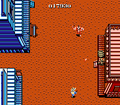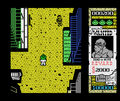Amstrad CPC
Ported by Topo Soft in 1987. Published in some regions by Capcom under the official title, and released in other regions as Desperado.
-
Screen
-
Box artwork
-
Desperado box
Commodore 64
A conversion created by Pacific Dataworks, released in 1987. Loosely based on the NES conversion, not nearly as accurate.
-
Screen
-
Box artwork
Famicom Disk System and NES
For more information about this version, see the Template:~.
This version of Gun.Smoke was first released in Japan on the Famicom Disk System, and was soon followed by a version on the NES for both the American and European markets. The NES and FDS versions are virtually identical, but with some slight differences. Like most FDS games, there are loading times in between levels. There's also no player demonstration like in the NES version. The font in the FDS version was the traditional Capcom-font, as seen in most of their NES games, while the font in the NES version was the military-style, as seen in the Arcade version. For some reason, the words for the opening storyline "In 1849" was changed to "In America" for the NES version. The wanted posters for the outlaws originally had an Anime look, and Bandit Bill's shirt originally had an open collar. In the NES version, they were given a realistic look, and a scarf was added around Bandit Bill's neck. After you beat the game the first two times, there is a Japanese message that tells you to beat the game again. This was thrown out in the NES version.
The most noteworthy difference in between the two versions is the music. It becomes evident as soon as you defeat Devil Hawk. Because of the limited memory on the disk cards, the level 1 theme is recycled in levels 4 and 6, the level 1 boss theme is recycled as the boss theme for levels 4 and 6, the level 2 theme is recycled in level 5, and the level 2 boss theme is recycled as the boss theme for level 5. Not long after the FDS was released, improvements were made to NES and FC cartridges. This gave Capcom the opportunity to add six new tracks for the game's soundtrack.
-
Screen
-
Box artwork
-
Box artwork
MSX
Ported by Topo Soft in 1987. Published in some regions by Capcom under the official title, and released in other regions as Desperado. An unofficial conversion of the NES game was also done by Prosoft,
-
Screen
-
Box artwork
-
Desperado box
Sinclair ZX Spectrum
Ported by Topo Soft in 1987. Published in some regions by Capcom under the official title, and released in other regions as Desperado.
-
Screen
-
Box artwork
-
Desperado box













